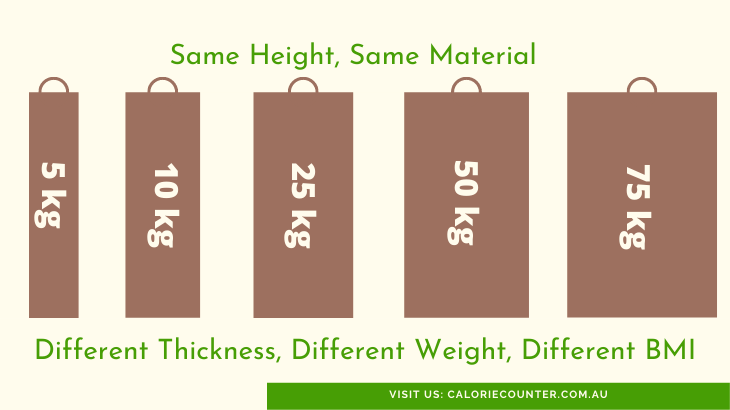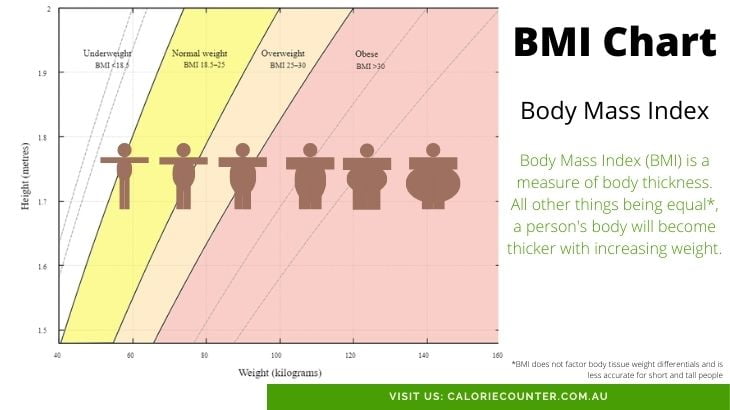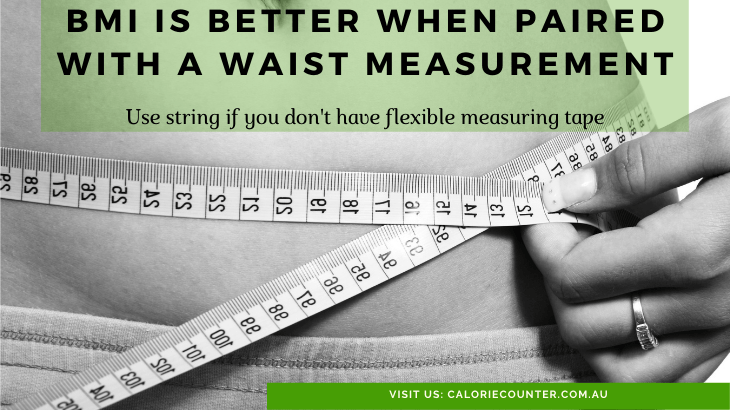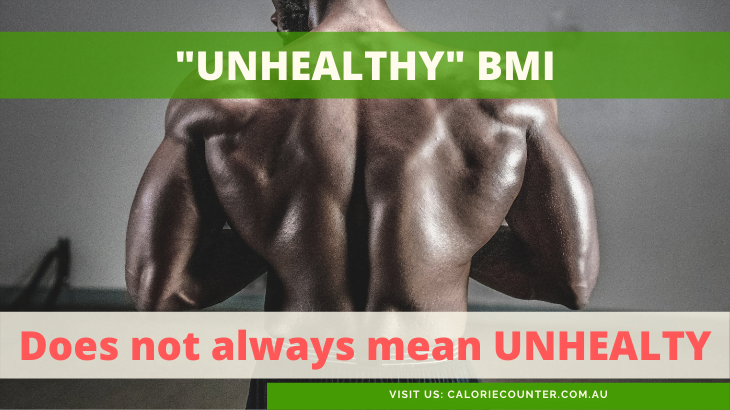Use this accurate BMI Calculator to find out what your Body Mass Index (BMI) is. Simply move the sliding scale or type in your current weight (kg) and height (cm) to see your calculated Body Mass Index. The BMI Calculator will display your BMI and BMI Classification below the sliders:
BMI Calculator for both Women and Men
This metric BMI Calculator is suitable for both women and men. We do not recommend its use for children. It is best to use this tool in combination with your waist measurement. Read on further to learn why Body Mass Index is such a popular method for defining what a healthy weight range is.
Body Mass Index classifies the body weights of different people, relative to a perceived good health ideal. It is probably the best framework to use in order to measure the relative healthy weight for most people.

Use our calcount Calorie Calculator to find out how many calories you need to change your BMI. Better yet, why not register a free calcount Calorie Tracker account to take full control of your body weight goals?
Body Mass Index Calculator
Body Mass Index (BMI) is a number calculated by applying a simple formula to a person’s height and weight. Doctors and other health professionals use it as a general measure of healthy body weight. This BMI Calculator uses the standard, widely accepted body mass index formula to generate results. It is a calculator of body mass, plotted on a health index which has been agreed upon by scientists the world over.
BMI and Your Health
Body Mass Index is a term which can cause confusion and misapprehension. People want to know what it is and how to work out BMI. This quick explanation might help to explain why BMI is better than simply comparing a person’s weight in kg or width in cm:

Measure of Heart Disease Risk
People whose bodies have large stores of fat are at higher risk of health problems than others. Excess fat increases the risk of heart disease, type 2 diabetes, and high blood pressure. So much research has found that excess fat causes poor health, that it is now taken for granted that being fat is bad.
Therefore, from a public health perspective, it is important for such people to become aware of their condition and increased risk. That way, they can try to do something about it. One way to make such people aware of their condition is to show them how they compare to other people who are at risk of adverse health outcomes. Body Mass Index/BMI is the most common measure of this comparison.
BMI is a Healthy Weight Comparison
Fat deposits add weight to human bodies. The more fat is added, the more body weight increases. A person who notices that their fat levels are increasing over time can monitor the rate of fat growth by measuring their weight periodically. Thus, the person can become aware of a possible problem if they notice that their body weight is increasing.
But there is a problem: the person may not know how much fat, is too much fat. Simply reading a scale will not indicate whether their body weight is “healthy”, or “unhealthy”. BMI solves the problem by comparing the person’s fat to everyone else’s fat.

BMI compares Thickness
How does one compare levels of body fat in different people? Simple: by figuring out how thick they are.
Fat attaches to tissue all over the body, but some body parts are less prone to attract deposits. Two of the “safe zones” in the body are the top of the head and the bottom of one’s feet. This means that fat growth does not make a person significantly taller. Body width and depth grow with increased fat deposits, but height stays the same. In other words, the body grows thicker, particularly round the middle.
When you gain body weight, you get thicker; when you lose body weight, you get thinner.
BMI measures thickness by providing a ratio of body weight to body height. The theory is that, all other things being equal, Person 1, who weighs more than Person 2, is thicker than Person 2.
BMI uses Thickness as a Health Risk Indicator
The World Health Organisation sets out what constitutes good and bad thickness values for health. They arrive at their classification by analysing health outcomes across massive databases of people with different BMIs. Depending on where a person’s result sits on a comparison chart, they are classified as having a healthy or unhealthy body weight.
BMI is easy to Calculate
BMI applies equally for both women and men, because it requires just two metrics which both men and women have (height and weight). Thus, the body mass index for men and women of the exact same height and weight is the same. It does not change with a person’s age, because the calculation does not require any inputs other than height and weight. To understand why body mass index is so convenient, just think about the BMI Chart:

BMI Chart (Healthy Ranges)
Quick and useful, the BMI calculation chart is a resource which can be found in most doctors’ offices. You can cross-reference your weight in kilograms and height in metres to find your result in seconds. BMI increases on a sliding scale as kg weight moves along the x axis. The different coloured bands on the chart indicate healthy and unhealthy weight ranges.

Whilst people have always instinctively judged their health and attractiveness by the shape and thickness of their bodies, graphing entire populations is a relatively recent phenomenon. In the mid-nineteenth century the concept of “social physics” began applying formulas to body height and weight to classify people.

Then, in 1972 Ancel Keys came up with the term “Body Mass Index” to flesh out the old social physics ideas and define relative obesity. Ancel Keys is a legend in the nutrition science field. Before his death in 2004, he published many seminal papers which laid the ground for much of what we now take for granted in the weight control field of study.
Health Risk Rating
A health rating which can reliably and easily compare everyone in a large population is clearly useful. It became possible for everyone to objectively compare themselves to their community by simply using a BMI chart to discover if they are in the healthy BMI range.
Calculate your own Health Risk
The widespread acceptance of the measure has led to agreed healthy and unhealthy ranges for BMI, plotted on a chart. Today, you can use a digital tool rather than a paper chart to quickly find your BMI. Online BMI calculators are often the first type of “weight checker” people turn to for reference.
What BMI is Overweight? How about the Healthy Range?
According to the BMI Chart, a Body Mass Index of above 25 is over the healthy range. The Overweight classification covers the range from 25 to 29.99. The Obese classification begins from 30 and extends up in increasing classes of obesity. Conceptually, the higher a person’s BMI above 25, the greater the health risk for that person. A result of 26 to 27 indicates that the person may be about 20% overweight and thus at risk of health problems like heart disease caused by excess fat.
BMI Calculator and Waist Size
Whilst BMI is a useful measure on its own for most people, it is more accurate when combined with a measure of waist size. People who have a BMI above 25 combined with a large waist size (100cm for men, 89cm for women) are at significant risk of weight-related health problems. Large waists in proportion to height and weight are an indication that excess fat may be deposited in the person’s abdominal region.

How to Measure your Waist
Sometimes, measuring one’s own waist can be confusing. Do you measure down by the hips or nearer the chest? Is it necessary to try a few times in different places to find the thickest or thinnest part? Take the uncertainty out of your measurement by following this four-step calcount guide:
- Ideally, remove your upper clothing, then using your fingers, find the bottom-most part of your ribs. This is the top point.
- Again, by feeling, locate the top-most part of your hipbone. It feels curved and is almost directly below the bottom of your ribs. This is the bottom point.
- Place a soft tape measure on top of an imaginary line which wraps around your waist, passing exactly half-way between these two (top and bottom) points. If you do not have a flexible measuring tape, use a piece of string. You can measure the string with a rigid tape measure afterward.
- Take the measurement after one normal exhalation (breathe out naturally, hold, measure). Do not clench or “suck your tummy in”.

Height, Waist and BMI don’t Match?
What does it mean if your waist girth is in the healthy range, but your BMI is in the unhealthy range? Or, what is your heathy weight status if your BMI is good but your waist measurement is bad? If this is the case for you, then one or more of the following is possible:
- You have lots of muscle, so that even though your weight is out of proportion to your height, you do not have much fat. This could result in an “overweight” BMI of 25 or more, combined with a relatively narrow waist. Muscle builds on the limbs, shoulders and upper back, so the waist remains narrow even at heavy body weights. To compound the situation, muscle is heavier than fat, by volume. If this situation applies to you, BMI is not the best method to use for calculating your healthy weight.
- You have little muscle, so that your weight is in the healthy range, but your waist circumference is in the unhealthy range. Some people call this condition “skinny-fat”. This usually results from a general lack of muscle or a disproportionately large amount of abdominal fat deposits. If this is you, then the BMI Calculator is not an ideal tool for finding out if your weight is healthy or not.
- You are either unusually tall, or unusually short. In this case you can use an alternative method such as waist to hip ratio, waist to height ratio, or body fat percentage to determine your healthy weight.
Got your Waist Measurement? Calculate your Waist-Hip Ratio!

Sometimes BMI gets it Wrong!
For reasons partly explained above, sometimes BMI simply does not work for some people. In some cases, a person may have a healthy BMI, yet have an unhealthy weight. In other situations, the reverse is true where the BMI is unhealthy yet the body weight is healthy! Common reasons for BMI “getting it wrong” are:
- Pregnant Women: A woman with child must necessarily have a thicker body, simply because there is a growing person inside of her. The weight of the child and extra body tissue increase her body weight disproportionally to her height. The pregnant woman thereby produces an unhealthy BMI, even though she has a perfectly healthy weight.
- Athletes: Bodybuilders and muscle-bound athletes may have body weights which would ordinarily put them in an unhealthy weight range. However, their “extra” weight comes from hypertrophy (lots of muscle) rather than excess fat. Muscle is not associated with poor health outcomes in the way that fat is. Thus, even with an “unhealthy” BMI, a muscled athlete has a healthy weight.
- Torres Strait Islander, Aboriginal, Polynesian, and some other broad population groups have statistically different body proportions to the populations from which BMI is derived. According to government reports, this may mean that people from these groups require a different range system.
- People with low muscle mass face the opposite issue to people with high muscle mass. A person with a low proportion of body weight coming from muscles may have a healthy BMI, yet still be overweight. This problem is an especial concern for the elderly, who experience age-related sarcopenia (muscle atrophy).